
Discover Marine Living Organisms With Us!
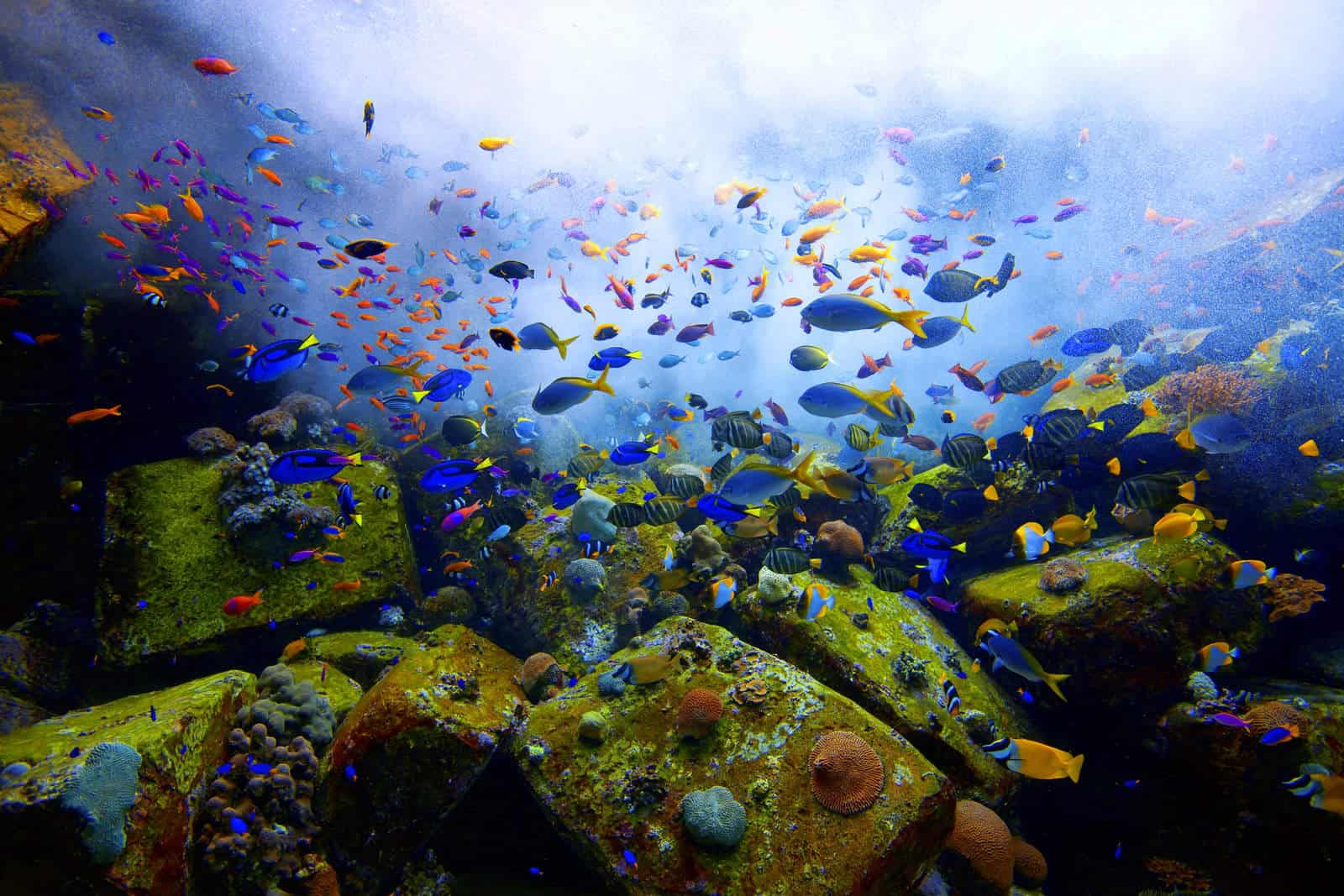
Our oceans are a peculiar and fascinating world. Many things live in this mysterious world and not just fish. From the single-celled organism, plankton, to the largest animal on Earth, the blue whale, these creatures keep our nature balanced and help us understand the Earth more. While there are still many marine living organisms undiscovered to this day, let’s look at some of these wonderful creatures. Get ready to pick your favourite!
But before that, let’s get to know how we classify animals and ultimately, classify ocean creatures.
Living Organisms Classification
Taxonomy is a very important scientific study that classifies biological organisms based on shared characteristics. The scientist who was behind the current system that is used to classify living organisms is called Carl Linnaeus. He called it the Linnaean System. Organisms are grouped into taxa (a unit of biological classification). These taxa are then given a rank and ultimately create a taxonomic hierarchy. The following ranks are used to classify living organisms:
- Domain
- Kingdom
- Phylum
- Class
- Order
- Family
- Genus
- Species
Did you know… The singular form of taxa is taxon.
Now, let’s get more specific and talk about each taxon in detail.
Domain
Domain is the highest rank in the taxonomic hierarchy and Species is the lowest. Domain has further three categories, and they are:
- Archaea (archaebacteria): These are single-celled organisms and live in extreme environments such as extremely hot areas or soils with high levels of acid.
- Bacteria (eubacteria): This domain is commonly known as true bacteria. This bacteria is found in almost every environment and it is a more common domain to find than Archaea. They cause diseases in humans, plants, and animals, but they also work as antibiotic producers and digesters in our stomachs.
- Eukarya (eukaryotes): This domain is different from Archaea and Bacteria because they have a nucleus in their cells. A nucleus is the part of the cell that contains the chromosomes. The Eukarya are further divided into four kingdoms which are: Protista, Fungi, Plantae, and Animalia.
Kingdom
Kingdom is the second highest rank in the taxonomic hierarchy. We are going to focus on the four kingdoms of the Eukarya domain.
- Protista: a unicellular eukaryotic organism that is usually found in environments with moisture and water. Examples of protists include slime moulds, protozoa, and algae.
- Fungi: they can be unicellular or multicellular. They do not produce their own food and obtain their nutrients through absorption. Some fungi are beneficial to us and provide us with many types of medication such as antibiotics and penicillin. Examples of fungi include mushrooms, yeasts, and moulds.
- Plantae: they are complex and multicellular organisms that are autotrophic, which means that they produce their own food via photosynthesis. Examples of Plantae include trees, ferns, and flowering plants.
Animalia: they are complex and multicellular organisms that don’t produce their own food. All species of the Animalia kingdom have some type of skeletal support and specialized cells. Their cells do not have walls and are organized into tissues. All species of this kingdom produce sexually. Examples of Animalia include humans, elephants, sponges, vertebrates, worms, and insects.
Phylum
Within the animal kingdom, to which we belong, animals are divided into 36 recognized phyla (the plural of ‘phylum’). Only nine of these phyla contain the vast majority of known species. The following table makes it easier to describe each of the nine phyla.
| Phylum | Characteristics | Examples |
| Porifera | – Marine aquatic organisms. – Their bodies are asymmetrical. – Their bodies have many pores called ‘ostia’ and a large opening at the top called ‘osculum.’ – They are hermaphrodites (eggs and sperm are produced by the same individual). – They can reproduce asexually by fragmentation or sexually by forming gametes (reproductive cells). – They are sessile (attached to a solid support and cannot move). – They are commonly known as sponges. | Giant Barrel Sponge |
| Cnidaria | – They are also called Coelenterata. – They are characterised by the distinctive presence of stinging cells called Cnidoblast and a cavity called Coelenterate, hence the names Cnidaria and Coelenterata. – They are all aquatic. – They are radially symmetrical. – They are diploblastic (have two germ layers, ectoderm and endoderm). – They exhibit two body forms, the polyp and medusa. – The polyp is sessile (sea anemones), whereas medusa is umbrella-shaped and free-swimming (jellyfish). | – Fried egg jellyfish – Moon jellyfish – Sea anemones |
| Mollusca | – Some are terrestrial and some are aquatic. – They are triploblastic, bilaterally symmetrical and coelomate (possess coelom between the body wall and digestive tract). – They have a cavity. – They are oviparous (they lay eggs) with indirect development. – They have an open circulatory system. – They have a rasping organ for feeding, called the radula. – Their body is divided into three parts: a head, visceral mass, and muscular foot. – Their bodies are covered by a calcareous shell. | – Caribbean Reef Octopus – Mussels – Snails |
| Platyhelminthes | – They are free-living or parasitic. – They are triploblastic, bilaterally symmetrical, and acoelomate. – Their body is flattened from top to bottom (that’s why they are called flatworms). – They are hermaphrodites. | – Planaria Fasciola (liver fluke) – Taenia solium (pork tapeworm) |
| Nematoda | – Their body is cylindrical and bilaterally symmetrical. – They are triploblastic and pseudocoelomate. – Some are parasitic and cause diseases. – Some are free-living in terrestrial and aquatic environments. – Their body is circular in cross-section (they are called roundworms). – They are dioecious (sexes are separate). | – Whipworms – Enoplea |
| Annelida | – They are aquatic or terrestrial. – Some are free-living and some are parasitic. – They are bilaterally symmetrical, triploblastic, and coelomate. – There is a closed circulatory system. – Some are dioecious and some are hermaphrodite. | – Nereis – Earthworms – Leeches |
| Arthropoda | – Insects, arachnids, and crustaceans are classes of this phylum. – They are bilaterally symmetrical, triploblastic, and coelomate. – They have exoskeletons, segmented bodies, and jointed legs. – They have an open circulatory system. – They are mostly dioecious. – They are mostly oviparous. – Their body consists of a head, thorax, and abdomen. | – White Shrimp – Red King Crab |
| Echinodermata | – These are spiny–skinned organisms. – They are exclusively free-living marine animals. – They can regenerate. – The adults are radially symmetrical while the larvae are bilaterally symmetrical. – They are triploblastic and coelomate. – They are dioecious and fertilization is usually external. | – Crown-of-thorns Starfish – Sea Urchins – Sea Cucumber |
| Chordata | All Chordata animals: – Have a notochord. – Have a dorsal hollow nerve cord. – Have endostyle or thyroid. – Have paired pharyngeal gill slits. – Are bilaterally symmetrical, triploblastic, and coelomate. – Possess a post anal tail and a closed circulatory system. Most Chordata animals are divided into three subphyla: Vertebrata, Urochordata, and Cephalochordata. | – Humans – Atlantic Bluefin Tuna – Polar Bear – Green Turtle |
Class
Class is the fourth rank of classification. Let’s take a look at the Chordata phylum, for example. It has three subphyla: Vertebrata, Urochordata, and Cephalochordata. There are many classes in the subphylum Vertebrata, including Cyclostomata, Chondrichthyes, Osteichthyes, Amphibia, Reptilia, Aves, and Mammalia.
| Vertebrata Class | Characteristics | Examples |
| Cyclostomata | – They are parasitic. – They are the only vertebrates without true jaws, and that’s why they are called Agnatha (jawless fish). – Their body is smooth and devoid of any scales. – They have no paired fins. – They have no exoskeleton and the endoskeleton is cartilaginous with no bones. – Their digestive system has no stomach. – Their heart has two chambers. – Their brain is visible. – An excretory system is present. – The sexes are separate, though some species of hagfish are believed to be hermaphrodites. | – Petromyzon: lampreys – Maxine: hagfish |
| Chondrichthyes | – They are mostly marine fish. – Their jaws are very powerful. – The mouth is present ventrally. – Their endoskeleton is cartilaginous. – Their teeth are modified placoid scales that are not attached to jawbones, but instead, are embedded in the tissue. The old teeth are constantly replaced by new ones. – They are predaceous. – They don’t have air bladders so they are constantly swimming to avoid sinking. – Their heart is two-chambered. – Sexes are separate and the fertilisation is internal. – Their gill slits are separate and without cover (operculum). | – Blacktip Shark Bull Shark – Cownose Ray – Blue-spotted Ribbontail Ray |
| Osteichthyes | They have a bony endoskeleton. They can be marine or freshwater. They have median and paired fins. Their tail is homocercal, meaning that it’s symmetrical. They have an air bladder which prevents them from sinking. Their mouth is terminal. They have four pairs of gills and they are protected by the operculum. Their skin is covered with bony dermal scales known as ganoid, or cycloid/ctenoid scales. Their heart has two chambers. They are cold-blooded (poikilotherms), which means that they cannot regulate their internal body temperature. The sexes are separate and fertilisation is usually external. They are mostly oviparous. | – Common Clownfish – Red Lionfish – Atlantic Bluefin Tuna – Bluehead Wrasse – Queen Angelfish – Banded Butterflyfish – Blue-banded Goby – Clown Triggerfish – John Dory – Nassau Grouper – Atlantic Cod |
| Amphibia | – They are multicellular vertebrates that live on land and in water, that is why they are called Amphibia, which means ‘two lives.’ – They are the first cold-blooded (poikilotherms) animals that have appeared on land. – Their skin is smooth and without scales. – Their skin has glands that make it moist. – They breathe through gills, lungs, and skin. – Sexes are separate and fertilisation is external. – They are oviparous. | – Toads – Frogs – Salamander |
| Reptilia | – The class name refers to their crawling mode of locomotion. – Their skin is dry and rough with epidermal scales known as scutes and without any glands. – Few of them shed their scales as skin cast. – Lungs are present to help with respiration. – Limbs may or may not be present. If present, they are two pairs. – Their heart has three chambers. However, the crocodile’s heart has four chambers. – They are cold-blooded (poikilotherms). – Sexes are separate and fertilisation is internal. – They are oviparous. | – Green Turtle – Banded Sea Krait – Saltwater Crocodile |
| Aves | – All birds are members of this class. – They are warm-blooded (homoiothermic), meaning that they can maintain a constant body temperature. – Their forelimbs are modified into wings. – They have feathers and can fly, except for flightless birds. – Their hind limbs have scales and are modified for walking, swimming, or clasping the tree branches. – Their endoskeleton is bony with long hollow bones filled with air cavities (pneumatic bones). – There are no glands on their skin except for the oil gland at the base of the tail. – Their jaws are modified into beaks. – They have no teeth. – Their digestive tract has additional chambers: the crop and the gizzard. – Lungs are present. – Their heart has four chambers. – Sexes are separate and fertilisation is internal. – They are oviparous. | – Crows – Pigeons – Ostrich |
| Mammalia | – They are warm-blooded. – The heart has four chambers. – They have milk-producing glands (mammary glands) to feed their young ones. – They are the most dominant form of animals that are found in all types of habitats. – Their skin possesses oil and sweat glands. – They possess different types of teeth. – Lungs are present. – Their skin possesses hair. – They have three middle ear bones. – They are known for the presence of a region in the brain called the neocortex. – They have large brains, larger than other vertebrates. – Sexes are separate and fertilisation is internal. – Some are oviparous and some are viviparous. | – Humans – Harp Seal – Orca – Polar Bear – Dugong |
Order
Order is the fifth rank of classification. Let’s take a look at some of the orders of Chondrichthyes, Osteichthyes, Reptilia, and Mammalia. We will look at one order from each class.
| Class | Order | Examples |
| Chondrichthyes | Carcharhiniformes | Blacktip Shark |
| Osteichthyes | Percopsiformes | Banded Butterflyfish |
| Reptilia | Crocodilia | Saltwater Crocodile |
| Mammalia | Artiodactyla | Orca |
Family
Family is the sixth rank of classification. The families in the previous table are as follows:
| Example | Family |
| Blacktip Shark | Carcharhinidae |
| Banded Butterflyfish | Chaetodontidae |
| Saltwater Crocodile | Crocodylidae |
| Orca | Delphinidae |
Genus
Genus is the seventh rank of classification. It contains animals that are closely related and share similar features. This rank contains one or two species. For example, both blacktip sharks and bull sharks belong to the Carcharhinus genus. The killer whale, or orca, belongs to the Orcinus genus.
Species
Species is the last rank of classification. Each species within the genus is named after its individual and unique characteristics. If two individuals of the appropriate sexes can breed successfully, they are a species. The scientific name of an animal consists of two Latin words. The first one is the genus and the second is the species. For example, the genus of humans would be Homo and the species is sapiens, so the scientific name would be Homo sapiens. Another example would be the blacktip shark; its scientific name is Carcharhinus limbatus, while the scientific name of the bull shark is Carcharhinus leucas.
Ocean Fish
There are more than 30,000 species of fish in our oceans. We are going to explore together some of these unique-looking fish. We will mainly focus on bony fish, or Osteichthyes, as we learned.
Atlantic Bluefin Tuna

First on our list is one of the strongest and fastest fish in the ocean world, the Atlantic Bluefin Tuna.
| Phylum | Class | Order | Family | Genus | Species |
| Chordata | Actinopterygii | Scombreformes | Scombridae | Thunnus | Thynnus |
- It is scientifically known as Thunnus thynnus.
- It belongs to the tuna species and is considered the largest tuna species. They are close relatives to the Pacific bluefin tuna.
- Atlantic bluefin tuna are born so small that you could see them under a microscope. However, in a span of three or five years, it becomes so gigantic that it reaches 1 metre in length. This makes the Atlantic bluefin tuna one of the largest predators in the ocean.
- Atlantic bluefin tuna are gigantic and huge. They can weigh more than 250 kilograms. The largest Atlantic bluefin tuna that was recorded in history weighed 900 kilograms and its length reached up to 4.6 metres.
- When Atlantic bluefin tuna are still young, they feed on zooplankton and other invertebrates, and the bigger they get the bigger their prey also gets. They also get eaten by several predators when they are young. These predators include sharks and killer whales. When Atlantic bluefin tuna reach adulthood, they mainly eat herring and mackerel.
Atlantic bluefin tuna meat is highly valuable all around the world. It is especially prized in Japan, the home of sushi. Due to the high demand for Atlantic bluefin tuna, its numbers drastically decreased in the Black Sea and the off coast of Brazil, where they formerly were more common.
Atlantic Cod

We have here one of the best-studied fish, the Atlantic cod.
| Phylum | Class | Order | Family | Genus | Species |
| Chordata | Actinopterygii | Gadiformes | Gadidae | Gadus | Morhua |
- The scientific name for Atlantic cod is Gadus morhua and they are found in the Atlantic Ocean near North America.
- They are known for their white and flaky flesh.
- Atlantic cod are bony fish with a barbel below their bottom jaw. It is believed that they change colours at different water temperatures. Sometimes their body can be grey-green and other times it appears reddish-brown. Almost their whole body is covered with dark spots except for their stomach. They also have two anal fins and three fins on the upper side of their body.
- Atlantic cod’s length can reach up to 2 metres and weigh over 96 kilograms. They feed on a variety of prey, including other bony fish, American lobster, molluscs, and other invertebrates. Their predators are large sharks, but what is more interesting is that the young Atlantic cod can become food to the adult ones, which makes them cannibalistic.
- Atlantic cod’s meat can be found as the base of many dishes in North America and Europe. But this has made the Atlantic cod population at risk these days. A study in 2012 showed that there were only 100 adult Atlantic cod left in the North sea.
- Atlantic cod usually travel in schools of fish.
Banded Butterflyfish

We now move on to one of the cutest fish you’re going to see, the Banded butterflyfish.
| Phylum | Class | Order | Family | Genus | Species |
| Chordata | Actinopterygii | Perciformes | Chaetodontidae | Chaetodon | Striatus |
- Banded butterflyfish is one of the 114 species of butterflyfish that are known to us. They are called butterflyfish because their skin is colourful like butterflies. They can be black, orange, yellow, red, and white.
- The scientific name for the Banded butterflyfish is Chaetodon striatus.
- Their body is white with black vertical stripes on it. They have black pelvic fins and their body has the shape of a flattened disk. They are about 16 centimetres in length, which is cutely small!
- Banded butterflyfish feed on coral reefs, invertebrates, and mollusc eggs.
- They can live alone, in pairs, or in small shoals of about 20 individuals for purposes of feeding.
- Large fish are their main threat. Their first instinct when these large fish are present is to flee. In case they can’t do that, they adopt a defensive posture as they lower their head and erect their dorsal spines in a way that tells the predator that they are too spiney to be eaten.
Did you know… Banded butterflyfish are known to clean other reef fish from parasites such as grunts and parrotfish.
Blue-banded Goby

We have here another splendid-looking fish! The Blue-banded goby looks exactly like its name.
| Phylum | Class | Order | Family | Genus | Species |
| Chordata | Actinopterygii | Gobiiformes | Gobiidae | Lythrypnus | Dalli |
- It is a red or orange-skinned fish with bright, blue stripes. It definitely is one of the most colourful fish in the ocean.
- The scientific name for this fish is Lythrypnus dalli.
- It can be found in the eastern parts of the Pacific ocean. Blue-banded gobies live their entire lives hiding amongst reefs and sea urchins. They do not like to stray away from their hiding places because of their fear of being devoured by larger fish.
- They use their teeth to break down and feed on small fish and some crustaceans.
- Blue-banded gobies have some superpowers! They have the ability to change their gender. It is said that most marine fishes can change their gender, but they can’t change it back to the original one. This is why the Blue-banded goby is special; it can change its gender back and forth.
Bluehead Wrasse

The Bluehead wrasse is one of the most studied fish.
| Phylum | Class | Order | Family | Genus | Species |
| Chordata | Actinopterygii | Labriformes | Labridae | Thalassoma | Bifasciatum |
- Its head has a beautiful blue colour and the rest of its body’s colour is blue blended with green or yellow. The juvenile’s body, however, is solid yellow.
- The scientific name for the Bluehead wrasse is Thalassoma bifasciatum.
- The Bluehead wrasse can be found in the Atlantic Ocean, New Mexico, and every Gulf state between these two points.
- It lives in the coral reefs and feeds on small invertebrates. The younger members of a group stay close to their families instead of wandering and exploring, in fear of large predators.
- The Bluehead wrasse fish uses a unique way of communicating with other members of its group. It produces sounds that can’t be recognized by the human ear and these sounds can be heard from miles and miles away. They use this way of communication to warn each other of an approaching danger so they can flee fast.
- The Bluehead wrasses are very cute fishes that pose no harm to humans. They can be the perfect pet for your aquarium.
Clown Triggerfish

We now introduce you to one of the most aggressive and colourful fish in the underwater world, the Clown Triggerfish.
| Phylum | Class | Order | Family | Genus | Species |
| Chordata | Actinopterygii | Tetraodontiformes | Balistidae | Balistoides | Conspicillum |
- It gets its name from its appearance that almost looks like clown makeup!
- The scientific name of this fish is Balistoides conspicillum.
- It is one of the 40 species of triggerfishes out there. They are called ‘triggerfish’ because of the reaction of their dorsal (back) fin spine when threatened. The first dorsal fin spine becomes erect when facing danger and is locked in place by the second spine, and the first spine cannot be lowered unless the second is pulled back, just like a trigger! That is why they got the name ‘triggerfishes.’
- All triggerfishes are known to have very strong jaws and broad teeth, and the Clown triggerfish is no exception. It uses its strong jaw and teeth to feed on hard-shelled invertebrates like sea urchins, crustaceans, and molluscs.
- Not many fish species are known to feed on the Clown triggerfish.
- They can grow to 50 centimetres in length.
- The Clown triggerfish’s habitat is in the Indian Ocean and the West Pacific Ocean.
- The Clown triggerfish is solitary by nature; it is rarely seen in pairs or in a group. It is only seen in pairs when it is trying to mate.
- They are generally very beautiful creatures with vibrant colours.
Common Clownfish

We have yet another clown! Common Clownfish is not your typical clown, but it is definitely smaller and cuter. The common Clownfish is perhaps the most iconic and famous ocean fish amongst children because of the Pixar movie ‘Finding Nemo.’ Some children might not believe it, but fish like Nemo actually exist in real life!
| Phylum | Class | Order | Family | Genus | Species |
| Chordata | Actinopterygii | Perciformes | Pomacentridae | Amphiprion | Percula |
- They get their name ‘Clownfish’ from their appearance which looks like clown makeup. They also swim in the water in a very goofy way, making clown-like moves. Let’s get to know some of the most interesting information on clownfish!
- The scientific name for the clownfish is Amphiprion percula. They also go by the name anemonefish.
Where do these goofy clownfish live? And what do they feed on?
- Well, they live in the Southwest Pacific Ocean, the Red Sea, the Indian Ocean, and the Great Barrier Reef in Australia.
Did you know… There are currently at least 30 types of clownfish known to us.
- Deep into the waters, clownfish live among parts of an interesting sea creature called the sea anemone. Anemones are known to be the ‘host’ to clownfish.
- Anemones and clownfish have a very interesting and beneficial relationship. Anemones give clownfish a home that protects them from predators by releasing poison and in return, the clownfish feed on the parasites that endanger the anemone’s life.
- There are more than 100 types of sea anemone, but only 10 are suitable hosts for clownfish.
Did you know… Clownfish are immune to the poison that anemones release, thanks to the extra layer of mucus on their skin.
- Clownfish are omnivorous, which means that they feed on both plants and meat. Their diet consists of plankton, molluscs, phytoplankton, small crustaceans, anemone parasites, and algae.
How do these fascinating fish reproduce?
- Actually, all clownfish that are born are males. When two male fish decide to mate, the biggest one of them changes its sex to female. Once they change their sex, they can’t go back to being male. The male then courts the dominant female until she decides to make a move. When she lays the eggs, the male does most of the ‘egg sitting.’
- Clownfish respect their hierarchy. The female becomes the leader of the school and when she dies, the dominant male becomes a female to take her place.
Let’s talk a bit about Finding Nemo. Nemo and Marlin (Nemo’s father) in fact belong to a species called false clownfish or false anemonefish (Amphiprion ocellaris). True anemonefish are what we have been talking about so far and they are called Amphiprion percula. Both false and true anemonefish are nearly identical, but they have a slight difference in shape and where they live.
John Dory

The John Dory is a famous fish that is targeted by commercial fisheries.
| Phylum | Class | Order | Family | Genus | Species |
| Chordata | Actinopterygii | Zeiformes | Zeidae | Zeus | Faber |
- The scientific name for the John Dory is Zeus faber.
- It is also commonly known as St. Peter’s fish.
- They are found on the coasts of Africa, Australia, Japan, New Zealand, South East Asia, and Europe.
- Its body is highly compressed and plate-like, with a large head and a large mouth.
- Its colour ranges from silver to olive-green, with a blue-black spot surrounded by a yellowish ring on each side of the body.
- It can grow up to 65 centimetres in length and 3 kilograms in weight.
- It can live up to 15 years. Females live longer than males.
- It lives close to the seafloor and can be found to depths of 200 metres, over both soft and hard bottoms.
- It is a solitary species but gets paired to reproduce.
- It preys on other fish, crustaceans, molluscs, and cephalopods.
- Large bony fish and sharks are their predators.
Did you know… The blue-black spot on John Dory’s body helps confuse its predators.
Nassau Grouper

It may not be the cutest fish around in the big marine world, but it surely is unique and has distinctive features.
| Phylum | Class | Order | Family | Genus | Species |
| Chordata | Actinopterygii | Perciformes | Serranidae | Epinephelus | Striatus |
- The scientific name for Nassau grouper is Epinephelus striatus.
- It is found on the coral reefs around the Caribbean Sea, the Bahamas, Florida, and the Gulf of Mexico.
- Nassau grouper can swim very deep, but it prefers staying close to shallow reefs and seagrass. Their juveniles stay closer to the coast near the seagrass that offers them protection.
- It is a very solitary fish, though they are occasionally observed to form a school with other fish when it is the spawning season. These groups are known as ‘spawning aggregations.’
- Although scientists classify this fish as endangered, it can live up to 29 years.
- It is reddish brown in colour with vertically striped bars across the head and body. Their tail has a black patch around it. This fish can change colours during mating. The body of the male becomes black on top and white below, while the female body becomes almost solid black.
- Nassau grouper is one of the biggest fish around! It can weigh up to 29 kilograms.
- One unique feature of this fish is the way they feed on its prey. It swallows the prey whole, without chewing! The lips on this fish are thick and it has a very large mouth that enables it to inhale large fish and whole lobsters. It has slender teeth but they are only for preventing the prey from escaping.
- It can change sex! It can change from a female to a male fish and this happens when they turn from juveniles to adults.
Did you know… Nassau grouper forms a mutualistic relationship with the wrasse fish where it allows the wrasse to clean its mouth from parasites, food particles, and dead tissues and in return, it provides the wrasse with food and protection.
Queen Angelfish
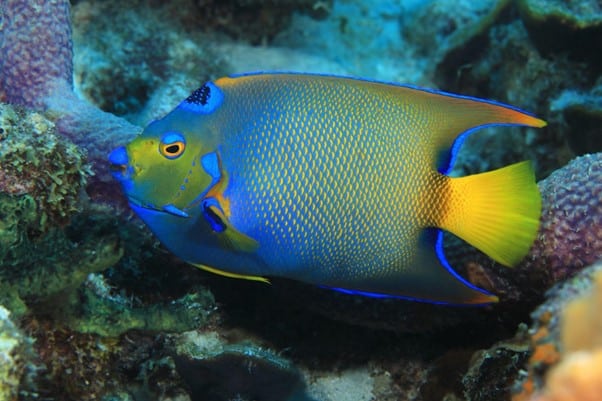
We have looked at clowns, and now we will introduce you to a queen! Queen angelfish is one of the most beautifully coloured fish in the ocean and it has a very good reason for why it is called a queen. Let’s discover the queen together!
| Phylum | Class | Order | Family | Genus | Species |
| Chordata | Actinopterygii | Perciformes | Pomacanthidae | Holacanthus | Ciliaris |
- Its scientific name is Holacanthus ciliaris.
- It is found on the coral reefs of the Caribbean Sea, the Gulf of Mexico, and the northern coast of South America.
- Its habitat can be shallow as well as deep ocean reef waters. It is found alone or as a pair at depths of 76 metres in the ocean.
- It is yellow and blue in colour, with a black spot on its head that has blue spots and looks like a crown, hence the name queen angelfish. Its dorsal and anal fins are outlined in blue colour. Its pectoral fins are yellow with a large blue spot at the base.
- The mouth of the queen angelfish is small and has bristle-like teeth.
- It can grow up to 45 centimetres in length and 1.6 kilograms in weight. Its body is compressed and disc-like.
- The queen angelfish is omnivorous and preys on plants and animals. Some of its prey include algae, sponges, soft corals, and invertebrates. The juveniles set up cleaning stations and feed on parasites and scales of other larger fish.
- Large fish, sharks and barracudas are known to feed on the queen angelfish.
Red Lionfish

Although it may not be as big as a lion, the red lionfish can be pretty dangerous.
| Phylum | Class | Order | Family | Genus | Species |
| Chordata | Actinopterygii | Scorpaeniformes | Scorpaenidae | Pterois | Volitans |
- The scientific name for this fish is Pterois volitans.
- It lives on the coral reefs of the Indo-Pacific Ocean and the western Atlantic Ocean.
- It gets its name from the long colourful fin rays that look like a lion’s mane.
- Like all species of the family Scorpaenidae, it has venomous spines to protect it from predators.
- Its body is brown or maroon with white bands covering the head and the whole body. It has tentacles above the eyes and below the mouth. It has 13 dorsal spines, 14 fan-like pectoral fins, 11 dorsal soft rays, 3 anal spines, and 7 anal soft rays. It also has cycloid scales.
- It can grow up to 38 centimetres in length and 1.4 kilograms in weight.
- Red lionfish are known to be top predators of the coral reefs of the Atlantic Ocean. They prey on small fish, shrimps, crabs, invertebrates, and basically anything that can fit their mouth. They eat them in one go and don’t chew. They are invasive and prey on more than 50 species of economically and ecologically important fish.
- Some of their predators include groupers, eels, snappers, and sharks.
Sharks and Rays
This group of animals may be top predators in the oceans, but they are actually very important to keep our ecosystem balanced. Sharks and rays belong to the Chondrichthyes class, along with skates and chimaeras. There are over 1000 species within this class.
The species within this class share some unique features. Their skeleton is made of cartilage instead of bones; cartilage is the flexible substance that forms our ears and nose. Only their teeth, and sometimes their vertebrae, contain calcium. They have the ability to replace their teeth with new sets. They have a pair of very powerful jaws that helps the catch and chew on their prey. Their skin is covered with placoid scales that are spiny and toothlike projections. They also have paired fins, a two-chambered heart, and a pair of nostrils. Some of the species possess electric organs or poison that they use to sting and defend themselves or for predation.
They have a complex digestive system, though not as complex as ours. It comprises a mouth, pharynx, stomach, intestines, and cloaca. The cloaca in females is part of the reproductive system. Adult males have claspers on their pelvic fins which they use to transfer sperms to the cloaca of the female. They are also poikilotherms, which means that they cannot regulate their internal body temperature. Here are some examples of Chondrichthyes:
- Sharks: the blacktip shark and the bull shark.
- Rays: the blue-spotted ribbon-tail ray and the cownose ray.
- Skates: little skate and small deepwater skate.
- Chimaeras: the whitespot ghost shark and the whitefin chimaera.
We will focus in this section on sharks and rays.
Blacktip Shark

The blacktip shark may not be the deadliest species of sharks out there, but it is definitely dangerous. Let’s discover more about this creature.
| Phylum | Class | Order | Family | Genus | Species |
| Chordata | Chondrichthyes | Carcharhiniformes | Carcharhinidae | Carcharhinus | Limbatus |
- The scientific name for this shark is Carcharhinus limbatus.
- The blacktip shark is found worldwide. It is found in shallow coastal waters.
- They can live for at least 12 years, sometimes even longer.
- They have black-tipped fins and this is where they get their name from. They have a vigorous body that is grey to brown above and white below, with a pointed snout. The teeth of their upper jaw are broad with narrow cusps, while the teeth of the lower jaw are narrow. They have five pairs of gill snits.
- Adult males can grow to 1.8 metres in length, while females grow to 1.82 metres. The largest recorded blacktip shark was a 2.47 m female.
- A baby blacktip shark is referred to as a pup, and some people find blacktip pups very cute!
- Blacktip sharks are not picky eaters. They attack schools of small fish. They eat a wide variety of fish such as herring, sardines, anchovies, sea catfish, and some smaller sharks like sharp-nose and smoothhound sharks. They can also consume rays, skates, cephalopods, and crustaceans.
- Blacktip sharks aren’t particularly aggressive towards humans, but being near them while they are swimming at full speed can be quite dangerous.
- There are no natural predators for these sharks. However, their pups can be eaten by larger sharks of other species.
Bull Shark

A simple look at the name will tell you that this may be one of the most aggressive shark species, and you are absolutely right. We will learn some interesting facts about the infamous bull shark.
| Phylum | Class | Order | Family | Genus | Species |
| Chordata | Chondrichthyes | Carcharhiniformes | Carcharhinidae | Carcharhinus | Leucas |
- The scientific name for this shark is Carcharhinus leucas.
- This shark can live in both saltwater and freshwater. It mostly lives in freshwater.
- It is known to be the shark species that comes in contact with humans the most because it lives in coastal areas. That’s why it is most likely to get attacked by a bull shark than any other species.
- It has a big plump body with a long pectoral fin and blunt snout. The body has a grey coat on top and white below.
- Similar to the blacktip shark, the female bull shark is bigger than the male. Adult males can grow to 2.1 metres in length, while adult females can grow to 3.3 metres. Adults can weigh between 91 to 227 kilograms. Pups can weigh around 3 kilograms.
- Bull sharks prey on small sharks, bony fish, and sometimes other bull sharks, which makes them cannibalistic. They occasionally eat sea turtles, crustaceans, birds, and dolphins.
Did you know… The bull shark has very special glands and kidneys that help it maintain salt in its body while it is roaming freshwater.
Blue-spotted Ribbon-tail Ray

We now reached one of the most unique-looking fish in the marine world. The blue-spotted ribbon-tail ray does not look anything like its savage cousins, sharks, but it has some deadly features.
| Phylum | Class | Order | Family | Genus | Species |
| Chordata | Chondrichthyes | Myliobatiformes | Dasyatidae | Taeniura | Lymma |
- The scientific name for this ray is Taeniura lymma.
- These rays are found along the coasts of the Indian and West Pacific Oceans.
- They have blue spots on their body as their name indicates. They have a deadly characteristic as they have two venomous spines at the tip of their tail.
- Blue-spotted ribbon-tail rays create electrical fields to communicate with other members and also to locate their prey, and this is why they are intimidating fish.
- The average weight of this ray is 5 kilograms.
- They are carnivorous and they prey on molluscs, crabs, and shrimps.
- They don’t have an air bladder, which is a gas–filled organ that helps fish to keep their body weight equal to the water volume so they don’t think. That’s why the blue-spotted ribbon-tail ray is always spotted sitting or sinking at the bottom of the ocean.
- Blue-spotted ribbon-tail rays are ovoviviparous, meaning that their eggs grew inside of the female’s body.
Cownose Ray

We have here a funny-looking ray with a funny name as well. Despite that, they are very dangerous to humans.
| Phylum | Class | Order | Family | Genus | Species |
| Chordata | Chondrichthyes | Myliobatiformes | Rhinopteridae | Rhinoptera | bonasus |
- The scientific name for this species is Rhinoptera bonasus.
- Cownose rays are found in the western and eastern Atlantic Ocean, the Gulf of Mexico, the United States, and the Chesapeake Bay.
- They get their name from their head which looks like a cow’s nose.
- They are found in groups called schools and are very social. They form large groups and migrate long distances.
- The average lifespan for males is 16 years while it is 18 years for females.
- Cownose rays are very dangerous to humans. They have venomous skin and stings.
- They have very strong teeth that can break soft and hard shellfish very easily.
- They are very active swimmers and they are rarely found resting.
- Their diet consists of shelled invertebrates including clams, snails, lobsters, oysters, and crabs.
- The average weight for Cownose rays is 23 kilograms.
Marine Mammals
Marine mammals are probably the most attention-getting ocean creatures amongst humans. They hold the characteristics of mammals and live in or near the ocean. They can be found all around the globe. What makes an ocean creature a marine mammal? The answer is found in the characteristics. Ocean creatures must meet the characteristics of the mammals to be called marine mammals, and these include:
- They breathe air through the lungs
- Are warm-blooded
- Have hair at any point in their life
Marine mammals are classified into four different groups, and these are:
- Cetaceans: these include whales, dolphins, and porpoises
- Pinnipeds: these include seals, sea lions, and walruses
- Sirenians: these include manatees and dugongs
- Marine fissipeds: these include polar bears and sea otters
We will know more about these groups through one marine mammal of each group.
Harp Seal
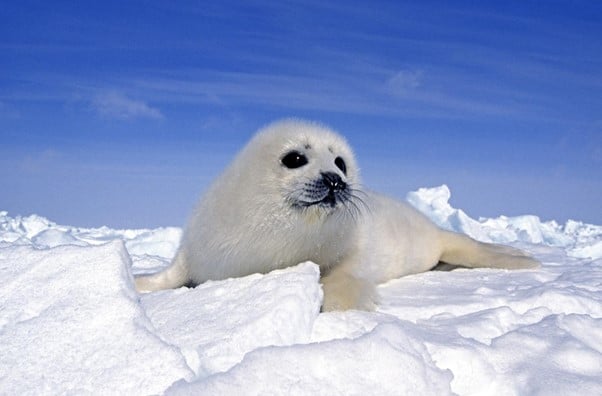
Harp seals are one of the cutest seals out there.
| Phylum | Class | Order | Family | Genus | Species |
| Chordata | Mammalia | Carnivora | Phocidae | Pagophilus | groenlandicus |
- They belong to the true seal family, and that’s because they have short flippers and no external ear flaps.
- They live in the cold waters of the North Atlantic and Arctic Oceans.
- Their scientific name is Pagophilus groenlandicus.
- Adult harp seals have light grey fur with a black patch on their back that looks like a harp, and this is where they get their name.
- Young harp seals are called pups and they are the cutest! Pups have white fur that helps them absorb sunlight to keep them warm while the fat under their skin develops. Their white fur lasts for about 2 to 3 weeks until they adapt to the cold weather.
- Harp seals can grow up to 5 or 6 feet (1.8m) long and their weight ranges from 260 to 300 pounds, which is nearly 136 kilograms.
- Harp seals spend most of their life in water, but they get on land or ice to give birth to the pups.
- Harp seals have such an amazing and versatile diet. They feed on many different kinds of fish and invertebrates (almost 130 species!). Some of the most famous small fish that harp seals prey on are capelin, Atlantic cod, and polar cod.
Did you know… Harp seals can live up to 30 years!
Orca
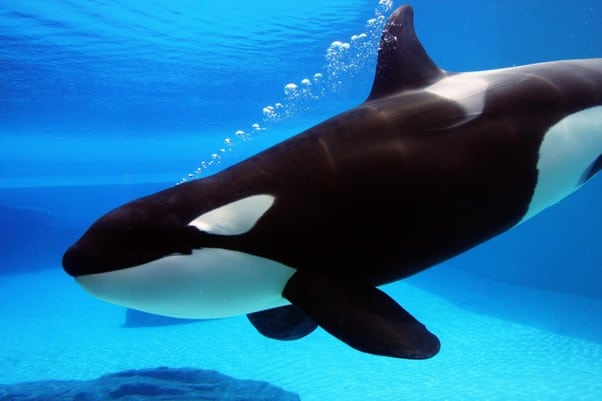
When you first look at orcas, you would think that they are a little bit cute, with their black and white skin. However, orcas are called ‘killer whales.’
| Phylum | Class | Order | Family | Genus | Species |
| Chordata | Mammalia | Artiodactyla | Delphinidae | Orcinus | orca |
- Though they are called ‘killer whales,’ they actually belong to the family of dolphins, and they are its largest member. You might think: “Why are they called ‘killer whales’ when they belong to the dolphin family?” Whales and dolphins are closely related. Ancient sailors gave orcas the name ‘killer whales’ because they observed them preying on bigger whales.
- Orca’s scientific name is Orcinus orca.
- Orcas feed on all kinds of marine animals. They consume fish, seals, sea lions, dolphins, sharks, rays, large whales, seabirds, squids, and more. But not many orcas are hefty eaters; some of them are actually very picky about what they eat.
- Orcas are big. They are one of the biggest sea creatures. They weigh up to 5443 kilograms, and their babies can grow as heavy as 158 kilograms.
- They are very cute and known to be loving towards humans. They rarely show any sign of aggression towards humans.
Did you know… Male orcas are called bulls and the female ones are called cows. Their babies are called calves. This naming might be due to the fact that their smooth black skin has white spots, just like a cow!
Polar Bear
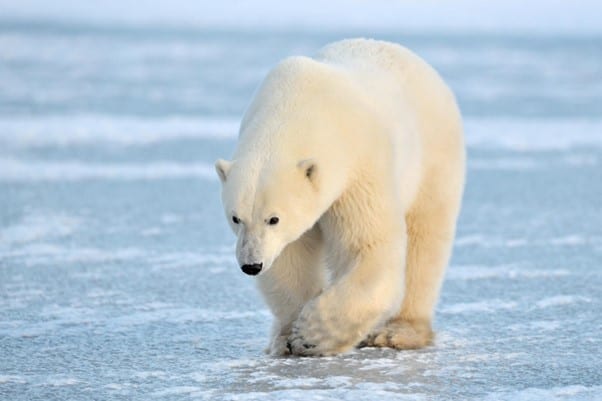
Next on our list is one of the most famous bears, the Polar Bear!
| Phylum | Class | Order | Family | Genus | Species |
| Chordata | Mammalia | Carnivora | Ursidae | Ursus | maritimus |
- It is also known by the name Ice Bear. Yes, the adorably famous Ice Bear from We Bare Bears!
- The scientific name for the polar bear is Ursus maritimus, which is literally translated to ‘sea bear.’
- As their name suggests, they live in the Polar Regions of the Arctic Circle.
- It is closely related to the brown bear. However, their anatomies differ. Because of the Arctic, semi-aquatic lifestyle the polar bear has, they have made certain adaptations. One of these adaptations is their big feet which are useful for swimming from one ice mass to the other.
- They are known to hunt ringed seal and bearded seal pups. Adult male polar bears are known to eat large ocean animals, like a beluga whale.
- Mating between the male and the female happens on the ice surface, but the females give birth to the cubs on land.
- Adult male polar bears can weigh up to 700 kilograms. The females weigh half of that. This enormous weight comes from the fat stored in their bodies.
- The fur on the polar bear’s body is very distinctive. It has two layers of fur and a layer of fat which keeps its body warm in the snow. The fur isn’t actually white, but rather translucent and is known to guard the black fur layer below it.
- Polar bears don’t have any natural predators. They fight amongst themselves and that could lead to killing. The cubs may be attacked by wolves. In case of survival, adult polar bears can be cannibalistic and eat other adults or even young cubs.
Dugong
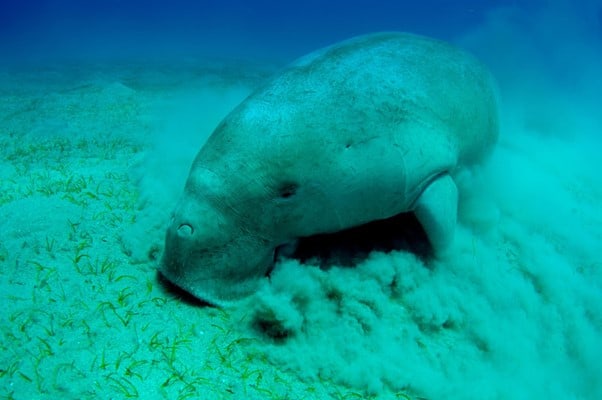
It may look weird, but trust us, Dugongs are very cute with their small round eyes and other features we will unravel together!
| Phylum | Class | Order | Family | Genus | Species |
| Chordata | Mammalia | Sirenia | Dugongidae | Dugong | dugon |
- Their scientific name may sound a little bit funny. They are known as Dugong dugon.
- They are also called sea cows because they are the only herbivorous marine mammal, meaning that they eat plants like sea grass and marine algae.
- Dugongs live in the coastal waters of Western Australia, the Western Pacific, and East Africa. They prefer living in turbid or murky water and they can’t tolerate freshwater.
- Dugongs live in pairs, though they can sometimes be found in herds of 7 to 10 dugongs. A herd of dugongs is called a nut cluster.
- Male dugongs are called bulls. The babies are referred to as calves. However, the female is not called a cow, although we see that it is a fitting name.
- Dugongs have unique physical features. They are actually mostly related to elephants because, like them, dugongs grow their trunks after maturity. Dugongs are bulbous and round and are brownish grey in colour. They have a downward snout and a broad upper lip which contribute to their cuteness!
- They can live up to 70 years and give birth every three to seven years.
Sea Turtles and Other Marine Reptiles
Reptiles are one of the earliest beings that inhabited the Earth. Some of them adapted to the aquatic or semiaquatic lifestyle in the marine environment. Some examples of the extant (living) groups of marine reptiles are sea turtles, sea snakes, and saltwater and American crocodiles.
Sea turtles have made some adaptations to survive living in the marine environment, with some unique features that help them do so. Like most marine reptiles, sea turtles require air to breathe and land to lay their eggs. However, they spend the majority of their lives underwater. Unlike their terrestrial relatives, sea turtles have flippers instead of feet. These flippers help them to be more hydrodynamic than their land-based relatives, meaning that they move smoothly and quickly through the water of the oceans. They also cannot retract their head and flippers into the shell like their terrestrial relatives.
When sea turtles eat underwater, they ingest a huge amount of salty seawater and this creates excess salt in their bodies. To get rid of this excess, sea turtles have glands around their eyes that help them release salt in high concentrations than the surrounding ocean water. These glands are why many observers of sea turtles think they are crying!
Sea snakes are some of the most venomous snakes of the Elapidae family. Although their venom is strong, they are not aggressive. There are 60 species and they are divided into two groups: the true sea snakes (subfamily Hydrophiinae) and the sea kraits (subfamily Laticaudinae). One way to identify sea snakes from their terrestrial relatives is by their paddle-like tales. Their tales help them move through the ocean water, but they make them clumsy when they try to move on land. Sea snakes are the only known reptiles to give birth in the ocean water.
Crocodiles are famous reptiles. However, we are only concerned with crocodiles that live in the oceans. We will talk more about the saltwater crocodile in the following section.
Green Sea Turtle
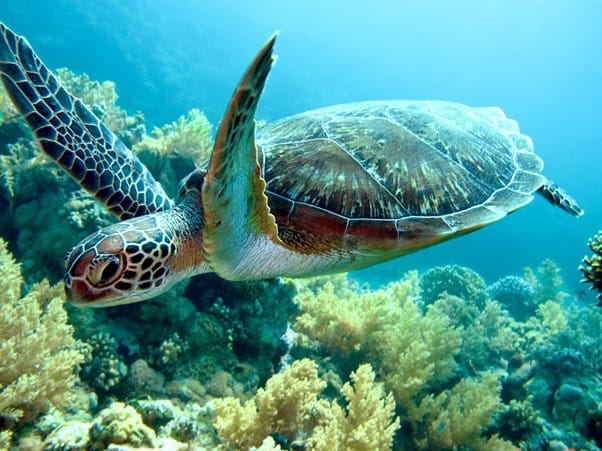
The green sea turtle is enormous and looks so cute with the patterns on its skin and shell that you might want it to be a part of your home aquarium! It is unique-looking and has some special features.
| Phylum | Class | Order | Family | Genus | Species |
| Chordata | Reptilia | Testudines | Cheloniidae | Chelonia | Mydas |
- The scientific name for the green sea turtle is Chelonia mydas.
- They are the largest hard-shelled sea turtle and the second largest to the leatherback turtle among all sea turtles.
- Green sea turtles get their distinctive name from the greenish colour of their fat and not from the colour of their skin or shell.
- They are found in the subtropical and temperate regions of the Atlantic, Pacific, and Indian oceans, and the Mediterranean Sea.
- Green sea turtles are the only sea turtles that are strictly herbivores. Their diet consists of seagrass and algae that they scrape off when they hang around coral reefs.
- Green sea turtles are pretty hefty. They weigh between 158 to 163 kilograms.
- The lifespan of a green sea turtle is around 70 years. However, they can live longer than that in captivity. Females reach maturity at the age of 25-35 years.
- Like other marine reptiles, green sea turtles come to the shore to nest.
Did you know… the oldest green sea turtle recorded is said to be 400 years old in captivity in the Guangzhou Aquarium in China.
Banded Sea Krait
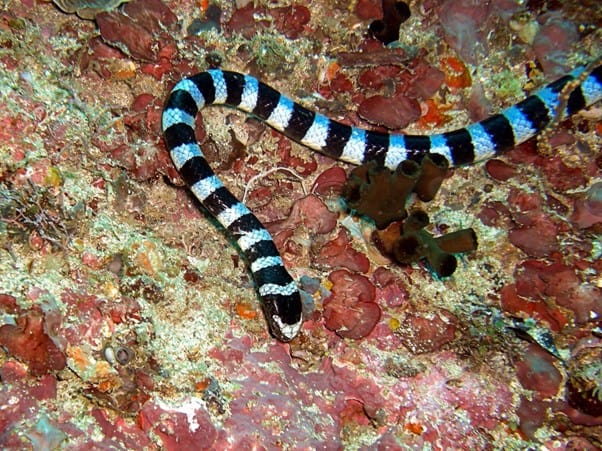
The banded sea krait may not be the cutest but definitely is one of the most venomous snakes. Let’s find out more about this dangerous, zebra-looking creature.
| Phylum | Class | Order | Family | Genus | Species |
| Chordata | Reptilia | Squamata | Elapidae | Laticauda | Colubrina |
- The scientific name for this snake is Laticauda colubrina.
- The banded sea krait is also commonly known by the name yellow-lipped sea snake due to the presence of a yellow upper lip and snout.
- It gets its name ‘banded sea krait’ from the dark, vertical bands on its white body.
- Unlike true sea snakes, banded sea kraits spend more time on land than in the ocean. They return to land to lay their eggs, shed their skin, and digest their prey.
- They are commonly found in the Indo-Pacific region. They live in the coral reefs in the deep sea waters.
- Their favourite food is eels! They paralyze their prey using their potent venom and swallow it whole.
- The banded sea krait female reaches a length of 142 centimetres, while the male reaches a length of 87.3 centimetres.
Saltwater Crocodile
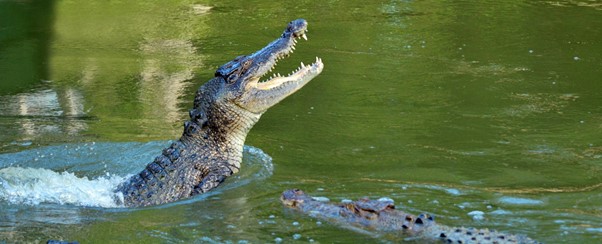
The saltwater crocodile is one of the scary-looking animals and is also one of the most interesting ones.
| Phylum | Class | Order | Family | Genus | Species |
| Chordata | Reptilia | Crocodilia | Crocodylidae | Crocodylus | Porosus |
- The scientific name for this crocodile is Crocodylus porosus.
- The saltwater crocodile is the largest reptile on Earth!
- It lives in the coastal waters of Australia, Bangladesh, Sri Lanka, Myanmar, and several regions of Southeast Asia.
- It is named for its ability to survive in full salinity seawater. However, it is usually found living in brackish water near the coast.
- It is known that most crocodilians are sociable animals. However, the saltwater crocodile is very territorial and can’t stand if other members of its species came into its territory.
- Saltwater crocodiles can live up to 70 years.
- Males can reach up to 7 metres in size while females don’t exceed 3 metres. This makes the saltwater crocodile twice as big as the Nile crocodile.
- Saltwater crocodiles weigh up to 1200 kilograms! They are quite hefty!
- They are carnivores and eat almost anything including small fish, other reptiles, wild boars, water buffalos, monkeys, and even humans! Make sure you stay away from them if you see one!
Corals and Other Invertebrates
This might be the most interesting section for us. We will discover here what corals are, what exactly an invertebrate is, and how they live underwater.
You know the colourful creatures at the bottom of the ocean that divers like to take pictures of because of their vibrant colours? These are corals! Though they look like plants, they are actually animals. They are marine invertebrates, which are animals that lack a vertebral column, or a backbone.
Corals fit the criteria that define animals; they are multicellular, they consume other organisms for nutrition (plants make their own food), they have an internal digestive system, they develop embryos, and they are capable of moving independently. Corals are often referred to as the rainforests of the ocean, due to their richness of life. They are an ecosystem of their own and a productive one as well.
The corals we see are made out of hundreds and thousands of creatures that are called polyps. Corals are closely related to sea anemones, which we talked about when explaining the common clownfish’s life. Corals and sea anemones share the same simple structure, which is the polyp. Each polyp has an open end that contains the mouth. This mouth is surrounded by a ring of tentacles which have stinging cells. These cells are called nematocysts that allow the polyp to capture small organisms surrounding it. The body of the polyp has digestive and reproductive tissues, the same as sea anemones. They differ from sea anemones in one aspect which is producing a mineral skeleton.
Corals have another source of food. The zooxanthellae are single-celled algae that use photosynthesis to pass on the food it makes from the sun’s energy to its hosts, the corals, so they can grow into the lively reefs we see. In exchange, corals give nutrients to the algae.
Let’s talk about invertebrates other than corals. More than 90% of the animals known to us are invertebrates. There are at least 36 phyla of the Animalia kingdom. There are six phyla of marine invertebrates animals, and they are:
- Porifera: such as sponges
- Cnidaria: such as corals, jellyfish, and sea anemones
- Annelida: such as segmented worms
- Mollusca: such as snails, clams, mussels, scallops, squid, and octopuses
- Arthropoda: such as crabs, shrimp, barnacles, copepods, and euphausids
- Echinodermata: such as sea stars, sea urchins, and sea cucumbers
Fried Egg Jellyfish
Fried eggs, anyone?
There are many interesting-looking jellyfish in the deep waters of the ocean. We’ll talk about a rather surprising-looking one. Fried egg jellyfish really look like they have a fried egg in their centre.
| Phylum | Class | Order | Family | Genus | Species |
| Cnidaria | Scyphozoa | Rhizostomeae | Cepheidae | Cotylorhiza | tuberculata |
- They are also called egg-yolk jellies.
- They have a bell that looks like an umbrella and another bell at the centre that looks like egg yolk.
- There are two species of these jellies. One is scientifically called Phacellophora camtschatica, and the other is called Cotylorhiza tuberculata.
- Phacellophora camtschatica is found worldwide in the Atlantic Ocean, Mediterranean Sea, and the Pacific Ocean. It has a transparent bell that looks like an umbrella with a yolk-looking bell in the centre.
- P.camtschatica feeds on other jellyfish and zooplankton. Its main body, called a bell, can grow up to 60 centimetres in diameter, with its tentacles growing up to 6 metres. Phacellophora camtschatica’s sting is actually very weak. It is ridiculously weak that some crustaceans ride on its bell and steal the food from its tentacles! It also doesn’t have any respiratory organs like lungs or gills. It breathes using a diffusing technique to diffuse the oxygen from the water by a thin sheet of tissues, called a membrane, that covers its body. It can live for several years.
- Cotylorhiza tuberculata, on the other hand, is found commonly in the warm water of the Mediterranean Sea. It has eight oral arms and between them, there are blue or purple tipped appendages. The colour of these appendages is due to the zooxanthellae algae in the tissues. Its bell can only grow up to 30 centimetres in width and its tentacles are short.
- C.tuberculata can swim on its own, unlike many jellyfish which rely on the currents to move them. Its sting is not harmful to humans. It has a very short lifespan and can only live up to 6 months.
Did you know… Adult jellyfish are called medusae.
Moon Jellyfish
The name ‘moon jellyfish’ is used to refer to all the jellies in the genus Aurelia. We will talk about the moon jellies that are found on both sides of the North Atlantic Ocean.
| Phylum | Class | Order | Family | Genus | Species |
| Cnidaria | Scyphozoa | Semaeostomeae | Ulmaridae | Aurelia | Aurita |
- Its scientific name is Aurelia aurita.
- It is found along the warm coastlines of the North Atlantic Ocean, the northwest Pacific, and South America.
- Moon jellyfish usually swim on the surface of the waters, but when they dive they can go as deep as 27 metres.
- Adult moon jellies (medusae) have a transparent umbrella margin membrane with tentacles attached to the bottom. They have four bright gonads (that look like neon lights) under their stomach.
- Their diameter can reach 40 centimetres in width. Their weight can only reach 3.2 grams.
- They don’t have any respiratory parts such as lungs or gills. Instead, they breathe by diffusing oxygen from the water through their thin membrane.
- Moon jellies’ diet consists of collecting medusae, plankton, and molluscs with their tentacles.
- Although the moon jelly’s sting is not fatal to us humans, it can cause great damage to the predators from which it protects itself.
- Sea turtles, birds, and other marine animals are known to feed on moon jellies.
- Moon jellies are often solitary but they can be seen travelling in groups called ‘blooms!’
Did you know… Moon jellies don’t actually have brains!
Giant Barrel Sponge
Let’s talk about sponges! The giant barrel sponge is not your typical sponge, but it is one of the most famous sponges from the underwater world.
| Phylum | Class | Order | Family | Genus | Species |
| Porifera | Demospongiae | Haplosclerida | Petrosiidae | Xestospongia | Muta |
- It is commonly known by its scientific name Xestospongia muta.
- The giant barrel sponge can be found on the coral reefs of the Caribbean Sea.
- It is one of the oldest species and it has been existing for more than 500 million years.
- Giant barrel sponges play a very important role in the underwater ecosystem. They filter the water and make use of the suspended particles and feed on them. They also help reefs with generation and provide a habitat for other invertebrates, fish, and bacteria.
- Giant barrel sponges can grow up to several meters in diameter, with the smallest individuals reaching one centimetre in size, and the largest ones reaching up to 2 metres in diameter.
- Giant barrel sponges are named like this because of their barrel-like shape. They have a wide hole on the top that is called the osculum. Smaller barrel sponges are corn-shaped. The thickness of the giant barrel sponge’s wall can be up to 2.5 centimetres at the top, and it increases as we move to its base.
- The surface of the giant barrel sponge can either be smooth or rugged with many small spikes. It is a sessile organism, which means that it is fixed in one place and cannot move. The colours of this sponge can vary from brown, reddish-brown, grey, and purple.
- Giant barrel sponges can catch a disease called ‘sponge orange band.’ In fact, the oldest giant barrel sponge that was discovered, which was 2300 years old, died from this disease.
- Giant barrel sponges are planktivores, meaning that they feed on planktonic organisms.
Crown-of-thorns Starfish
The crown-of-thorns starfish doesn’t look like the typical starfish that you would find on the beach while you’re on a vacation.
| Phylum | Class | Order | Family | Genus | Species |
| Echinodermata | Asteroidea | Valvatida | Acanthasteridae | Acanthaster | Planci |
- The scientific name for this starfish is Acanthaster planci.
- Like all the species of the phylum Echinodermata, if it loses a part it can regenerate.
- It can be found in the Indo-Pacific region, including the Red Sea, the South Pacific, and the coasts of Japan and Australia.
- There are millions of crown-of-thorns starfish and they are known to cause the destruction of coral habitats because they feed on them. There are so many of them due to the overfishing of its primary predator, the giant triton.
- These starfish look like most starfish, with a central disk from which arms are extended. Their arms are soft and covered with spines. These spines help them against predators. Their arms are also prehensile, meaning that they can grab onto things. An adult crown-of-thorns starfish can reach up to 35 centimetres in length and can have more than 20 arms. Its colour ranges from bluish-purple, red, grey, and green.
- The spines of these starfish are packed with neurotoxins and starfish poison. Both of these are dangerous to humans and marine creatures. The poison contains saponin, which is a poisonous chemical compound. The sting can cause numbness, tingling, nausea, and body pain.
Did you know… Crown-of-thorns starfish gets its name from its thorn-like spines that look like the biblical crown of thorns!
Cephalopods, Crustaceans & Other Shellfish
Shellfish play an important role in keeping ocean systems healthy and balanced. They help in filtering the water from suspended particles and contaminants, which contributes to the quality and clarity of the water. There are different types of shellfish, including many species of molluscs, which include cephalopods like squids and octopuses. Other types of shellfish include crustaceans like shrimps and crabs.
Crustaceans: they have a crust on top of their body or a shell, which acts as a sort of protection for their body. Well-known crustaceans are crabs, like the red king crab, and shrimps/prawns, like the white shrimp.
Cephalopods: they are members of the molluscan class. They have their legs over their head. Famous cephalopods include squids and cuttlefish, which have internal shells or fins, and octopuses, which have 8 tentacles instead of internal shells or fins. Fishers refer to cephalopods as ‘inkfish’ and that’s because they release black ink that works as a smoke screen and helps them run away from predators.
Caribbean Reef Octopus
| Phylum | Class | Order | Family | Genus | Species |
| Mollusca | Cephalopoda | Octopoda | Octopodidae | Octopus | briareus |
- The Caribbean reef octopus is a unique octopus species that lives, as the name suggests, around the Caribbean range of the Atlantic Ocean.
- Caribbean reef octopuses are cephalopods.
- Their scientific name is Octopus briareus.
- They are great at deception and tricking their predators so they wouldn’t know they just missed a delicious meal. They can change their colour and texture so they can match the reefs they are surrounded by and thus, trick their predators -which are sharks and other bony fish-.
- Caribbean reef octopuses are nocturnal creatures, meaning that they emerge at the night. They live in shallow waters, making dens around coral reefs.
- They are known to like living alone and don’t interact with others until it’s the mating season.
- Their diet is quite diverse. They eat shrimps, spiny lobsters, crabs, and small fish. However, they also are known to prey on their own species, which makes them cannibalistic.
Striped Pyjama Squid
| Phylum | Class | Order | Family | Genus | Species |
| Mollusca | Cephalopoda | Sepiida | Sepiadariidae | Sepioloidea | lineolata |
- The striped pyjama squid is scientifically called Sepioloidea lineolata.
- Although it has ‘squid’ in its name, it is actually a species of cuttlefish. Striped pyjama squids normally have white skin with thin brown stripes. They have an internal shell, eight arms, and two feeding tentacles, which have tiny suckers on them.
- The striped pyjama squid is often known as the striped dumpling squid, because of its round and small appearance, just like a dumpling!
- These fascinating creatures are found in the shallow water ranges from the Great Barrier Reef to South Australia.
- Like other small cephalopods, they can camouflage themselves and fit in their surrounding environment to deceive their predators.
- And like its relative, the Caribbean reef octopus, the striped pyjama squid is a nocturnal being. They emerge at night and feed on small shrimps and fish.
- The way this cuttlefish reproduces is very unique. The male grasps the female and makes a head-to-head connection with her. He then lays down his sperm packet close to her mouth so she could store it until she lays her eggs. If the male finds another male’s sperm packet in the female’s mouth, he removes it and replaces it with his. What’s even more interesting is that the male usually dies after breeding.
- Striped pyjama squids fascinatingly converse with each other, which is their skin. They use the pigmentation on their skin to communicate with each other and rely on the information. They also use their swimming postures as well as waving their arms and tentacles as other ways of communication.
Red King Crab
We all know the famous Mr Krabs from SpongeBob SquarePants. We have here his relative, the Red King Crab.
| Phylum | Class | Order | Family | Genus | Species |
| Arthropoda | Malacostraca | Decapoda | lithodidae | Paralithodes | camtschaticus |
- The scientific name for the red king crab is Paralithodes camtschaticus.
- The red king crab is called ‘king’ because of its gigantic size, which is bigger than any crab species.
- Red king crabs live in North American waters, along the coast of the Gulf of Alaska, and south to British Columbia, Canada.
- Red king crabs have a spiny exoskeleton which provides them with protection from their protection. Their colour ranges from brownish to bluish red. They have five pairs of legs. The first pair represents their claws or pincers, with the first claw being the largest in adults to crush their prey and the other is smaller for other soft food items. The following three pairs represent their walking legs, and the fifth pair of legs are small and usually tucked under their spiny exoskeleton.
- Red king crabs belong to the superfamily of decapod crustaceans. They are closely related to blue king crabs and golden king crabs.
- A male red king crab has a triangular abdominal flap and it is called a ‘buck.’ The female has a rounded abdominal flap and is called a ‘jenny.’ A newborn red king crab is called ‘zoea.’
- Red king crabs are omnivorous, meaning they eat both meat and plants. They eat anything they can crash with their claws. The young ones eat algae, small worms, small clams, and other various small animals. Adults have a much more versatile diet that includes worms, clams, mussels, barnacles, fish, sea stars, sand dollars, and brittle stars. Adult red king crabs can sometimes be cannibalistic and feed on their own species.
Did you know… 1- Red king crabs’ blood is blue because it has hemocyanin.
2- Red king crabs can only grow by moulting, which means that they shed their old shell and grow a new one. While they are growing the new shell, they are more prone to predation.
White Shrimp
Let’s talk about the white shrimp! You might be having it for your next meal, but they are much more than just a delicious meal.
| Phylum | Class | Order | Family | Genus | Species |
| Arthropoda | Malacostraca | Decapoda | Penaeidae | Litopenaeus | setiferus |
- The white shrimp’s scientific name is Litopenaeus setiferus.
- White shrimps can be found in the Gulf of Mexico and the South Atlantic Ocean.
- The white shrimp is also called the Atlantic white shrimp, southern shrimp, common shrimp, green shrimp, lake shrimp, and grey shrimp.
- Like the red king crab, and other prawns and lobsters, the white shrimp is a decapod crustacean. It has ten walking legs and five other pairs to help it swim. The five swimming pairs are located at the front of their abdomen. The white shrimp’s body has a shell that is basically its skeleton, like all decapods. The exoskeleton protects the white shrimp from potential predators. The white shrimp female has a slightly bigger body than the male. The female body is around 20cm and the male one is around 18cm. Both the female and male have a blueish-white body. They have a black tail flipper with yellow and green margins and pink sides.
- White shrimps are omnivorous in nature and their diet can range from small fish, plants, and invertebrates. They can also be cannibalistic, devouring other shrimps.
Did you know… White shrimps develop fairly fast, depending on the water temperature, but their lifespan is short, usually less than 2 years.


Leave a Reply